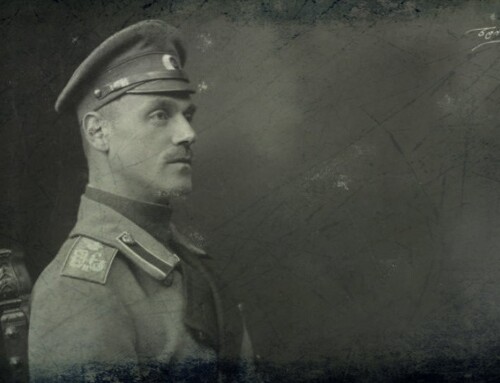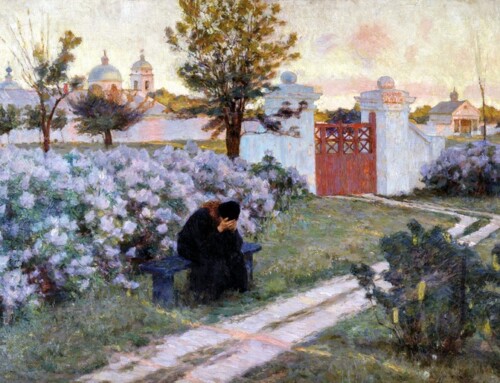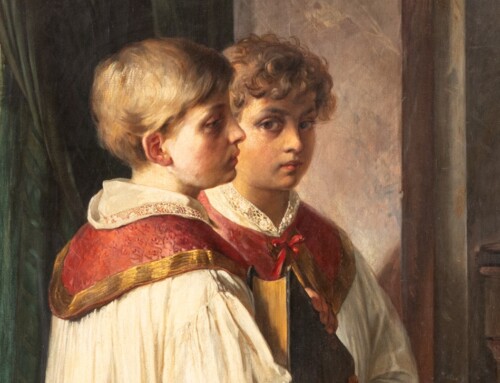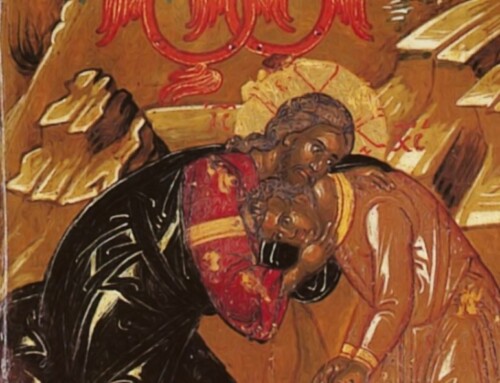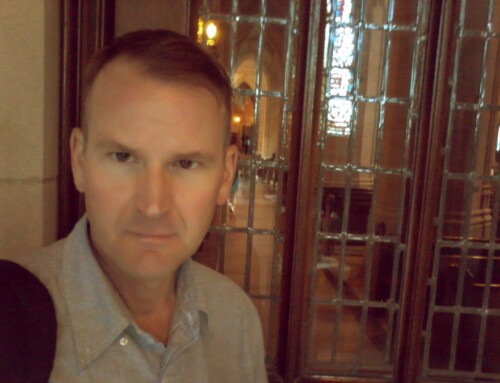“…in my absence, work out your own salvation with fear and trembling.” – Philippians 2:12
A good father should want his children to fear him – just a little bit. Otherwise, they would have almost no reason to listen to him; or respect him. Of course, one should do so out of love. But I did not even begin to admire my father until I was well into my 30s. Before that, at best, I regarded hum as a nuisance; although more often than not – I envisioned my father as my oppressor. Until about age 19, I longed to free myself from his domineering influence – and his judgement. I naively believed that once I was away from him, and able to make my own choices, my life would be easy – and endlessly happy. It wasn’t. Like the proverbial “prodigal son,” everything descended rather quickly into the depths of the mud. At that moment, I still feared my father; however, I had had nowhere else to go. So, I went home. But instead of damnation, I found consolation.
One of my favorite movies is the 1947 film “Life with Father,” which details the bombastic personality of the patriarch of the Day family in 1880s New York City. Mr. Day is the father of 4 boys and runs a tightly-wound household like a well-oiled machine; in some way, my own father was a more blue-collar version of Mr. Day: rather distant and hypercritical, but with a heart-of-gold. Only, when someone is a child, its difficult, sometimes albeit impossible, to see the softer side of your father that is buried beneath a hardened exterior; especially if you are a particularly sensitive boy. But what seems to make all the difference in the Day home – is Mrs. Day. I think the boys instinctively understand that their mother is incredibly influential, but like most smart women – she doesn’t flaunt her domestic power. Consequently, she often intercedes for them. Its in this sort of symbiotic and complementary relationship between male and female that the extremes in each sex (brutality in men; and succoring in women) are either abrogated or heavily diminished.
Yet, many who were raised Christian remain constrained by a fearful perception of God; hence, it is no coincidence that men in particular attach their view of God with their relationship with their father. This phenomenon was expertly expressed by Chuck Palahniuk in his 1996 novel “Fight Club.” Also, a gay man, a cohort that is notoriously distant from their fathers, Palahniuk wrote about how God the Father and someone’s biological father can merge in the minds of some men:
“If you’re male and you’re Christian and living in America, your father is your model for God. And if you never know your father, if your father bails out or dies or is never at home, what do you believe about God?”
He continued:
“What you end up doing, is you spend your life searching for a father and God…What you have to consider, is the possibility that God doesn’t like you. Could be, God hates us.”
This mindset is particularly strong in Roman Catholicism and within its offshoot of Protestantism – and the numerous sects that subsequently broke away. Leading up the pivotal date of 1054 AD, the West began to emphasize complete submission and obedience to the so-called Vicar of Christ. Almost immediately, corruption and abuse were endemic in this new system of control; in 1051, already St. Peter Damian had to pen a treatise against the practice of sodomy by Catholic clerics. The faithful, unless directly involved, were probably largely unaware. But the laity were expected to grin and bear it; remaining always the faithful. This outlook of a wrathful God persists to this day in Protestantism with the successful “Left Behind” movie franchise.
By the 13th century, the growing precipice between the suffering laity and the distant elite clerical system of the Catholic Church gave rise to the humanitarian revolution of St. Francis and the early Franciscan brothers who reached out to the forgotten, the poor, and the diseased. Only Francis was applying balm to fatal wounds. Fear had been ingrained into Roman Catholicism – most perfectly illustrated in their obsession with the crucified “Christ,” in contrast to the focus on the glorified resurrected Jesus in Eastern iconography. This emphasis on the suffering of Christ would become more and more pronounced and bloody – reaching an apogee in Latin America with grisly depictions of the scourged Christ on the cross – helping to give rise to the heresy of Liberation Theology. In the Middle Ages, over the doorways to the new Gothic churches, tympanums illustrating the sometimes-horrific details of the Last Judgement greeted Catholics as they entered. What awaited the vast majority was a continuation of suffering – in the newly devised realm of purgatory; except for those who could afford to purchase numerous indulgences, or embark on a Church-sanctioned “crusade.” When the “Black Death” struck Western Europe in the mid-14th century, it seemed that many had already survived hell. Scare tactics didn’t seem to work anymore.
Following the Second Vatican Council, everything seemed to change. By the time I came around, the battle over tradition and modernism in the Catholic Church had been won by the revolutionaries. Consequently, at least in California during the 1970s, I grew up with the image of a hippie Jesus. I didn’t fear him. In fact, he became ordinary to the point of irrelevancy; this perception became markedly acute once we were forced to receive Communion in the hand. That little bit of remaining mystery was obliterated. My sense of fear in church resided mainly in the black box of the confessional and then within the creepy familiarity of the so-called “reconciliation room.” This is where the sinner received their “penance.” When I was a kid, that meant praying the rosary or reciting a series of prayers – like 10 Our Fathers or 20 Hail Marys. It made prayer into a punishment. Infrequent attendance at Sunday Mass was semi-intolerable. In the midst of it, I usually lied and said I had to visit the restroom in order to gain a short reprieve. In high-school, the occasional school Mass was an opportunity to sneak away and spend the afternoon at the mall. Because, by then, the Catholic liturgy (especially those that were supposedly designed to appeal to teenagers) were incredibly cringe-worthy: bad acoustic guitar-playing, weird overly-eager priests, and forced acceptance of communion. No one wanted to be there. Fear had been transformed into farce. In Catholic parochial schools, the idea of religion and God himself had become a punishment.
In the gay environs of San Francisco, I often witnessed a strange reenactment of Christian ritual and practices – including flagellation. Largely unknown in the East, within the Latin Church, flagellation and self-flagellation became commonplace among both male and female monastics – and following the crisis of the Black Plague, bands of the laity formed maniacal throngs of flagellants who left a gory trail through Western Europe. At first, inside the fetish dungeons – I noticed how many men were willing to undertake a rather severe process of self-punishment that sometimes drew blood. Instinctively, I think they knew that their lives and the world around them had become perverted and unmanageable; therefore, unable to rid themselves of the demons from the past – they took part in some sort of weird secular exorcism. Except, it never worked. The heaviness of the trauma only got heavier; towards the end of my existence in this world – it felt as if I were always wearing weighted space-boots.
This desperation towards a sense of meaning and escape from an incurable oppression is widely evident in public exorcisms within American evangelical sects and the continued obsession among Roman Catholics with “celebrity priest” exorcists and movies about diabolical possession (from “The Exorcist” to “The Pope’s Exorcist.”)
Fr. Seraphim Rose, who battled his own personal demons, once gave this advice to a sinner struggling with sexual proclivities:
“Do not be afraid to confess the fleshly sins. Do you think you are so holy? God allows you to fall in order to humble you. Get up and walk in fear and trembling. Struggle against them, but do not despair, no matter what happens. Strength in Orthodox firmness comes very gradually; what you do every day helps build it up; and if you fall, humility and self-awareness build it up.”
Without a major fall – literally facedown into a gutter in San Francisco, I never would have reconsidered my choices, or the circumstances that brought me there. I needed to wallow with the pigs like the “prodigal son.” And when I finally realized it – I was scared. I feared for myself. I thought I was going to die; and I did not want to breathe my last breath here – and like this. I didn’t have any options. No one was there – except Jesus Christ. He reached out His hand towards me. And I wasn’t afraid.
When I returned to Catholicism, I became immediately terrified. The priests, I thought. Those honored arbiters of God’s forgiveness. While some were caring and compassionate, others were perverse and predatory. But I believed that I had to pass through these guardians at the gates in order to find Christ – and to attain His forgiveness. How much could I endure? I tried. I flipped from one parish to another. From one priest to another. Finally finding a bit of sanity and solace at the Traditional Latin Mass. But I couldn’t hide. For Roman Catholicism, especially after the date of 1054 AD, seemed to oftentimes draw an odd lot towards the priesthood; from St. Ignatius who wore chains, hairshirts, and cords below his habit to Marcial Maciel who sexually abused seminarians and fathered illegitimate children. There is a fear of God that creates self-abuse; while simultaneously promoting and protecting those who prey upon others who exploit this fear.
“God is love; and he that dwells in love dwells in God, and God in him…Perfect love casts out fear.” – I John 4:16, 18
Resembling a contestant on Joe Rogan’s old reality television series “Fear Factor,” I was willing to do almost anything. But like those hapless participants on the show, I kept thinking to myself: What will they make me do next? I couldn’t tolerate it any longer when my salvation required looking the other way while people (not unlike me) were being abused, deceived, and manipulated. That’s was too high of a price to pay. And I was afraid again. Whenever I outwardly questioned anything about the Roman Catholic faith, the most aggressive adherents would almost always retort with: “Where will you go?” And it was those words that kept reverberating in my mind. This was a form of utilizing fear as a means of control.
For many years, since I once met a former member of The People’s Temple while I lived in Berkeley, I’ve been rather morbidly fascinated by the events at Jonestown in 1978. While not so much interested in the reasons why so many “Temple” members chose to commit mass-suicide, I was puzzled why so many chose to stay in Jonestown – despite the constant abuse that they had to endure. I think part of the reason is because they genuinely believed that they had nowhere to go. For many, Jonestown was not only their home, but where most of their family and friends resided. The settlement was surrounded by miles of impenetrable jungle. And for years, they’d been told that the world was an ugly and hostile place. In Catholicism, particularly in Traditional circles, I constantly heard that there was “no salvation” outside the Catholic Church. That the Pope was the “Vicar of Christ.” And that a priest is “in persona Christi.” As in various cults, where leaders become gods, I wondered if leaving the Catholic Church meant that I was abandoning God. By disobeying these men, I disobeyed God. I feared such leaders in the Church, more than I feared God. In Traditional Catholic, as well as progressive circles, various cardinal, bishops, priests, and of course the pope, replaced Christ as the center of attention. It was an ugly situation. Catholics hung on every syllable uttered by anyone in a red zucchetto – as if their life depended on it. But it did. And they were afraid.
“For God hath not given us the spirit of fear; but of power, and of love, and of a sound mind.” – II Tim. 1:7
For many years, I would sporadically visit the Russian Orthodox Cathedral of Our Lady in San Francisco. Since early childhood, I’d been drawn to the mystery of Eastern Orthodox icons. Among the few items that my father carried with him from his homeland of Sicily to the United States was a reproduction of Our Lady of Perpetual Help. Perhaps stolen from Constantinople during the tragic 4th Crusade, the original Byzantine icon resides in Rome and hence became an object of intense devotion among Italians. As a boy, I sat and stared at it. Like the Russian Cathedral itself, I was instantly entranced by it – and somewhat fearful. The dark and intense gaze of the Theotokos that seemed to pierce through me. I only approached this object with a sense of trepidation. Only, this was a different sort of apprehension; a fear and trembling that is filled with beauty and wonder. Shadows, candlelight, incense, silence that is punctuated by the deep baritone of the choir, the voice of the priest, the sound of bells – all uniting in a singular prayer to God. In my religious life as a Christian, the only time I ever approached this kind of amazement was during a moment in the Traditional Latin Mass – though that form of liturgy always seemed to solely engage the mind and much less so the heart. Much of the mystery was absent. But as the icon became a doorway to the sacred, the Orthodox liturgy created a portal to God – where the sacred doors were finally opened.
Fear of God will ultimately set us free; for then we are doing the Will of God. The great St. Seraphim of Sarov said: “There are two kinds of fear. If you want not to do evil, fear the Lord and do not do it; and if you want to do good, fear the Lord and do it.” He continued: “When the mind is set free from care, then the fear of God will move it and bring it to the love of God’s goodness.” Like the son of a good father, at first – when we are children, we love and fear him; then, through the process of accepting his rules and regulations – we come to love him for his caring and wisdom. But our father merely conveys that knowledge from God, he does not create it. A father that solely utilize fear as a means of obedience, is not a good father. As the author of “Fight Club” described in his book – you ended up hating such a man. Thus, the reason for continued violence and self-destruction within Latin Christianity and the eventual rise of nihilism.
One of my favorite icons is the appearance of the Theotokos (with Apostles Peter and John) to St. Sergius. Behind St. Sergius is his disciple, Micah. Cowering in fear; usually with his hands covering his face, Micah is afraid to even look at the vision. In “The Northern Thebaid,” loving translated by Fr. Seraphim Rose, we learn how Sergius and his brothers were filled with “indescribable joy.” For every journey undertaken, even life itself, will inevitably begin with fear; but no matter the hardships along the way – we can pray that it ends in joy.

